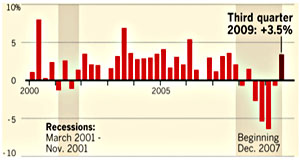 No surprise here: GDP was up 3.5% in the third quarter. But is the growth sustainable?
No surprise here: GDP was up 3.5% in the third quarter. But is the growth sustainable?
The cash-for-clunkers program helped boost consumer spending on durable goods….Similarly, economists say the $8,000 federal tax credit for first-time homebuyers helped revive spending on housing.
….Stagnant consumer demand and withering consumer confidence have left companies wary of hiring more employees — or, for that matter, taking any expensive risks. The jobless rate reached 9.8 percent in September, its highest rate in 26 years. According to Thursday’s report, business investment in buildings and other structures fell at an annual rate of 9 percent in the third quarter.
The Wall Street Journal also provides a note of skepticism: “Since the federal stimulus reached its maximum effect in the third quarter and the unemployment rate remains high, there’s uncertainty over the sustainability of the recovery.” As for myself, I’m curious to know not just where the growth is coming from, but where it’s going to. Wage growth has been weak this year, and there’s not much sign that the recovery in Q3 did much to change that. So who’s getting the bulk of the benefit?













